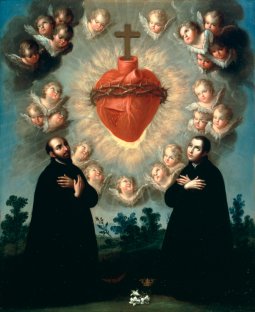 I wasn’t raised Catholic, but even after I became one, I used to think of the devotion to the Sacred Heart of Jesus as something outdated and hyper-pious—an attitude no doubt reinforced by bad artistic representations of Jesus’ heart.
I wasn’t raised Catholic, but even after I became one, I used to think of the devotion to the Sacred Heart of Jesus as something outdated and hyper-pious—an attitude no doubt reinforced by bad artistic representations of Jesus’ heart.
Over time, I noticed that various saintly people had a devotion to the Sacred Heart (including Pope John XXIII), but it wasn’t until the mid ’90s that I discovered the Litany of the Sacred Heart when a priest encouraged me to pray it during Lent. I found that it opened up my prayers in new and unexpected ways.
In truth, this devotion had been sneaking up on me for a long time before I actually discovered it. Despite my initial aversion to the traditional Sacred Heart imagery, a spirituality of the heart has always appealed to me. Growing up, I always liked the part of the service in the Book of Common Prayer that enjoined us, “Lift up your hearts.” (On the other hand, I did not respond well to being pressured “to invite Jesus into [my] heart,” then and there, by a woman who had asked me to lunch one day when I was a student at Smith. I told her to leave me alone and let me eat my tuna-fish sandwich.)
Just after becoming a Catholic, I began to attend a largely Mexican parish in the Mission District of San Francisco. I was drawn by its warm, heart-centered style of devotion. On Holy Thursday, for example, there was a procession of children carrying pastel candles and flowers to the altar of repose, in front of which several kneeling women sang enthusiastically. I would often spend time meditating, praying, and just sitting in front of their Sacred Heart statue, though Christ’s heart was not the focus of my prayers. I just felt drawn there. At the time, I was renting a room from an elderly lady. She was very kind to me and would give me “a grandmother’s blessing” with holy water whenever I left the house. She was in the Blue Army, and my friends called her “the dear fanatic.” Her house looked like a religious objects store: a huge picture of Jesus in Gethsemane at the head of the stairs, a statue of St. Rosalia on the kitchen table, and in the front window one of those pictures that changes from the Sacred Heart to the Immaculate Heart of Mary depending on the angle from which you see it. Every now and then I would wonder what on earth an educated woman like me was doing in such a place. But oddly enough it felt comforting, and I came away from my time in that house with a new affection for some of the traditional Catholic devotions I used to dismiss.
Around the time I started praying the Litany some years later, I had an experience that marked me deeply, and I later came to associate it closely with the Sacred Heart of Jesus. Camping in Maine, I felt moved by the Holy Spirit to drink from a nearby spring. Jesus offered “living water” to those who thirst and associated it with the heart: “He who believes in me, as the Scripture has said, ‘Out of his heart shall flow rivers of living water’” (John 7:38). This passage prefigures the moment after Christ’s death on the cross when “one of the soldiers pierced his side with a spear, and at once there came out blood and water” (John 19:34). What might have looked like a confusion of images in Christ’s words (hearts filled with water?) is here reinforced by his body in this small miracle, which we remember when the priest mixes water and wine at the Eucharist.
The devotion to the heart of Jesus helps one to think of conversion (metanoia) in affective terms: as a matter of receptivity and fullness and not merely an act of the will. In Christ’s heart, divinity meets and embraces humanity, so that God can touch our hearts through a heart like our own. Christ’s heart is the point of contact between the temporal and the eternal: “Heart of Jesus, holy temple of God, have mercy on us. Heart of Jesus, tabernacle of the Most High, have mercy on us. Heart of Jesus, house of God and gate of heaven, have mercy on us.”
I still meditate on at least part of the Sacred Heart Litany every day and continue to find nourishment in it. The verses are theologically rich; some of them are also poetic and beautiful. They take us through Christ’s Incarnation, life, passion, and Resurrection, up to the delight we hope to share with the saints. To prepare for that delight, and to get a glimpse of it, we pray, “Jesus meek and humble of heart; make our hearts like to yours.”
Please email comments to [email protected] and join the conversation on our Facebook page.
Previous Story
Religion Booknotes
Next Story
Christopher Lasch; leaving the church


